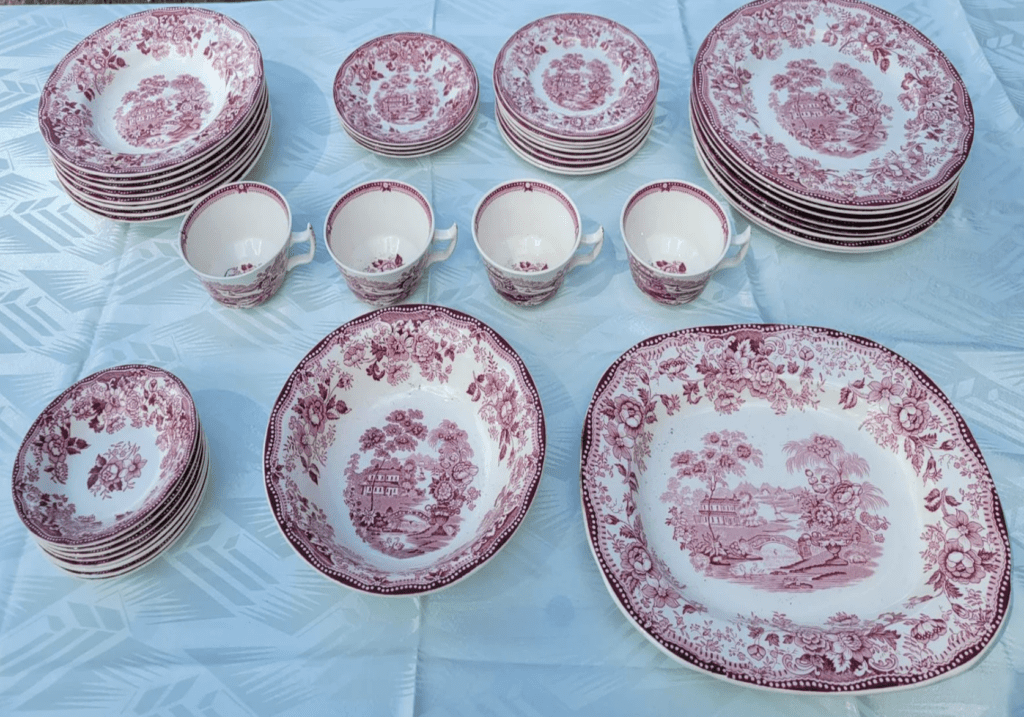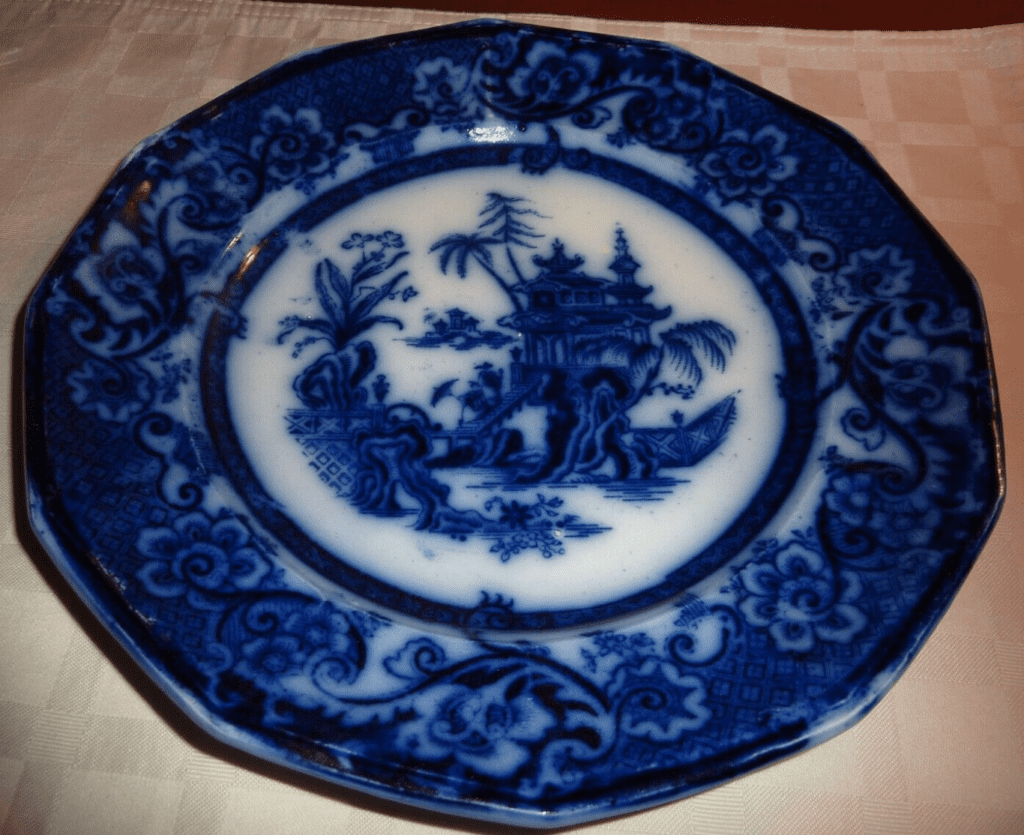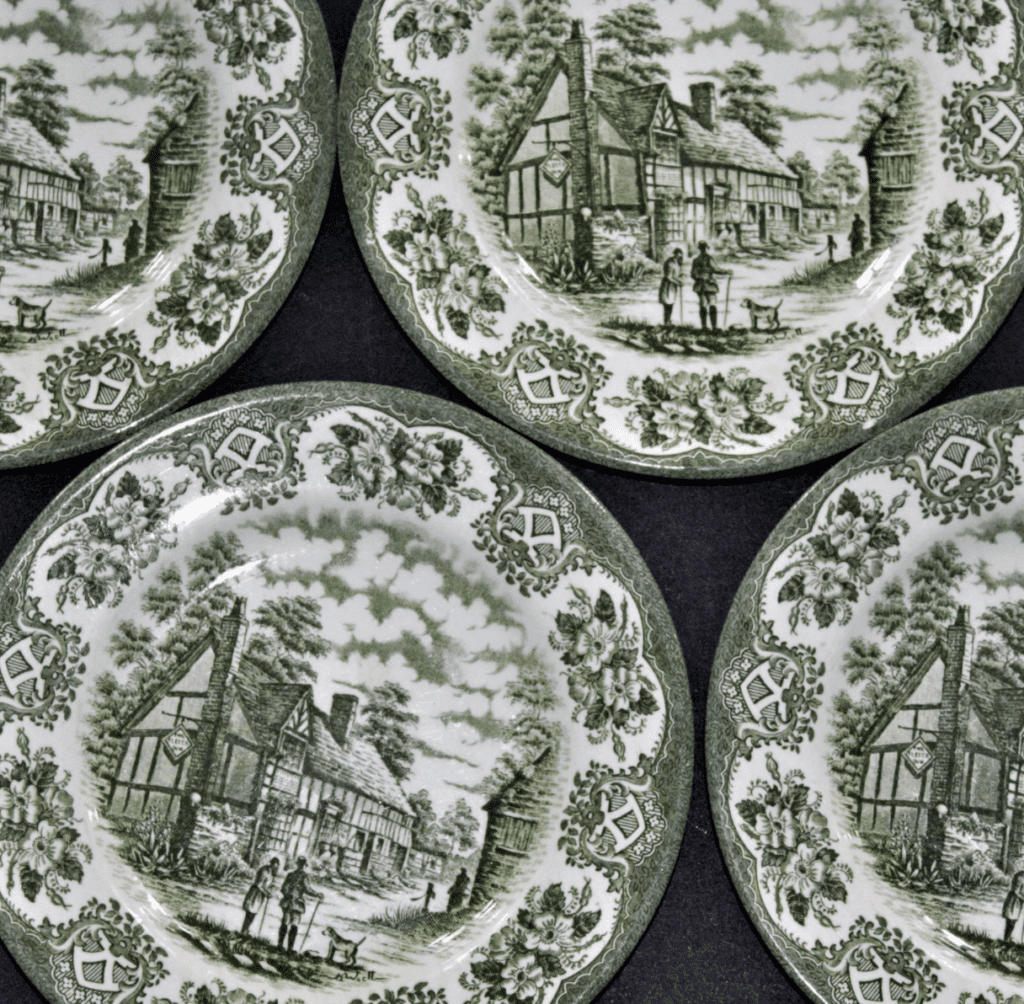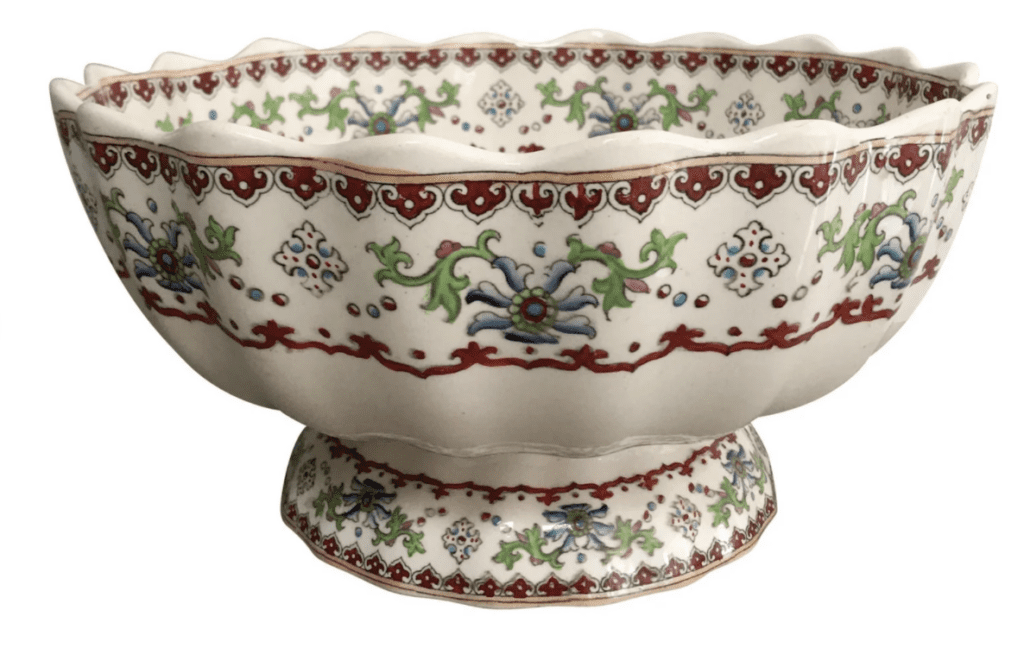In the world of antique pottery, there is nothing quite as intricate or beautiful as transferware. These endearingly unique dishes attract collectors and home designers alike. What is it that makes transferware so special?
Transferware is a kind of pottery made by transferring a customized print from special paper onto earthenware or a porcelain dish. Depending on its age and condition, a piece of transferware can be incredibly valuable. This 200-year-old art form continues to grow in popularity even today.
For anyone interested in creating, selling, or appraising transferware, there is a wealth of information available. From its historic origins to its modern uses, here is everything you need to know about transferware.

What Is Transferware?
Transferware is a style of pottery characterized by intricate patterns and images transferred onto dishes. Hence the name “transfer-ware.” These artistic dishes often depicted images of young lovers, heroic figures, the countryside, floral designs, and other nostalgic, pleasant scenes.
Generally, transferware can be identified simply by the color and characteristics of its featured design. These dishes are typically white, providing a clear background for the details of the image. The ink most commonly used to transfer patterns is a dark blue color, though other colors were certainly used at the peak period of production. Transferware pieces can be found in red, pink, purple, cranberry, brown, black, green, yellow, gray, or even a combination of colors, and may be more valuable than traditional blue pieces based on rarity.

Although exact dates and locations remain debated, most historians and antique experts agree that the transferware technique originated in England around the 1750s and was an adaptation inspired by Chinese, hand-painted porcelain.
At first, European potters imitated the patterns, styles, and motifs of the Chinese. Years later, the novelty of transferware exploded in popularity. As transferware grew in popularity, the patterns that distinguished it became more anglicized. Thousands of individual patterns were created and tens of millions of pieces were produced.
Demand for transferware only increased as the English middle class began to boom, accounting for the contemporary ubiquity of these beloved dishes in the mass market. European potters often strove to imitate the blue and white hand-painted porcelain of the Chinese, adapting the designs to reflect western culture.

Rising to meet the demand for more affordable tableware, the new resources and machinery of the Industrial Revolution enabled artists and potters to commoditize items like transferware.
With an etched master plate from which to copy hundreds of images, the production process took less time than ever before, thereby lowering the price for middle- to lower-class customers. Because transferware was significantly easier to produce than hand-painted china, members of the upper class began to view it as utilitarian and therefore less valuable.
During the peak of transferware production, approximately 90% of the dishes were made in and sold from Staffordshire, Leeds, Liverpool, Swansea, and Scotland. But by 1820, the English had established such an international affinity for transferware that even after The War of 1812, artists succeeded at attracting American customers with dishes featuring American landscapes, buildings, war heroes, and patterns.
Today, the craft remains alive as antique collectors seek valuable pieces from the past and artists toy with modern twists on the beloved decorated china.
How Is Transferware Made?
Transferware is renowned for its one-of-a-kind detailed designs, an artistic uniqueness which, with the exception of hand-painted work, was difficult to accomplish. To achieve such a high level of intricacy and precision, artists first etch the pattern onto either a copper or a steel plate, a process that can take up to a month per picture. The copper plate is then covered in ink and scraped horizontally, evening out the amount of color prior to application.
Immediately pressing a piece of tissue paper onto the engraved plate, the potter then transfers the inked image onto the surface of a piece of porcelain. The newly patterned dish is then placed in a kiln, enabling the ink to adhere and a final glaze to set. Earthenware is the most common base for transfer patterns, followed by ironstone, porcelain, and bone china.
Transferware is still made today, using modern methods that move beyond the older, more labor-intensive strategies. In this video, a modern artist demonstrates the process of transferring an intricate design from paper onto a plate, describing the steps necessary in order to ensure minimal mistakes and the cleanest transfer possible.
What Is Transferware Worth?
Because of the time and skill required to produce them, antique pieces of transferware are valuable items at any antique store or pawn shop. If the piece is old or hand-painted it has a higher chance of being valuable.
Hand-painted pieces can be identified simply through close inspection. If the transfer shows a stippling texture (a pattern of raised dots rather than brush strokes,) it was most likely hand-painted. This painting technique is intended to have a tonal effect on the porcelain and indicates a significant amount of time and artistic skill.
Another factor in determining the value of transferware is a rarity. Some colors, like yellow and red, are rarer than blue and therefore often sell for a higher price. Though blue was the original color of ink used in the art of transferware production, other colors began to appear with frequency around the same time throughout the mid-1800s.

Some collectors look for the name of the artist on the bottom of transferware pieces. While the provision of a name is certainly a historic perk when it comes to tracing the piece’s exact origins, the good news is that a printed name is not necessary in order for a transferware dish to be valuable. Many pieces designed and completed by anonymous makers remain valuable and collectible if they are of good quality.
Other than make and age, the value of transferware depends mainly on supply, demand, and condition. If there are plenty of transferware pieces available but few customers interested in the market, prices will be low. Even the most beautiful dishes can have little value if no one is searching the market for them. Additionally, pieces with common patterns or in poor condition have little value beyond being simple home décor.
When there is a high demand for transferware, even damaged pieces can have value. Still, the more in-tact the piece is, the higher the price it will fetch. For many collectors, chips, cracks, or repairs are noticeable and therefore undesirable. Since flawless transferware is the most preferred among buyers, it is becoming increasingly rare and increasingly valuable.

To gain a better sense of the demand for transferware in your area, search online for listings and dealer offers. Internet auctions and local listings can also be informative platforms for discussing transferware with other collectors and knowledgeable antique lovers.
How Can You Tell the Age of Transferware?
The general appearance of the pattern of the pottery can be a helpful indicator in determining the age of the item. Most of these dates are approximate, but the closer to early 19th century British manufacturing, the better. Using the details of the pattern for reference, appraisers can trace the pottery to certain manufacturer’s books, registry marks, invoices, and even documented items of correspondence. Many historical references books contain all of this information and more.
These methods are a good start and certainly a fascinating endeavor, but the only definitive way to determine the age of a piece is to search for an impress date on the whiteware. In pottery, ‘white ware’ is a term used to refer to dishes that are fired prior to decoration. Dates on these wares were often imprinted prior to firing in the kiln, sealing in permanence their historical nature and value.
Not every potter engaged in this practice, but in the areas where it was a common step in the production process, impress-dating is invaluable. Originally, the purpose of impressing a date on each piece was not for historical context but the practicality of manufacturing. In other words, these dates helped store owners asses older material compared to newer material, keeping wares up to date and in line with rapidly advancing trends.
Here are some examples of how impress-dates functioned:
- The date was indicated by a unique format, months by the corresponding number 1 through 12 (i.e. May = 5), years by the last two digits, with the implication that it was the nineteenth century (i.e. 42 = 1842), and an equal sign was used, rather than a dash (i.e.”5 = 42″).
- Other date forms used the first letter of the month to indicate the month a piece was made (i.e. August of 1853 would be “A = 53”) or a horizontal line separating the month above the year (i.e. October of 1878 as “10/78”).
- Particular manufacturers, such as W.T. Copeland & Sons, used a combination of these techniques (i.e. October of 1830 as “O/30”).
The Encyclopedia of British Pottery is a great resource for more detailed information on impress-dates.

Some impressed dates are difficult to read due to a poor imprint or small typesetting. Collectors recommend using a 3-power magnifier with an 8-power inset (rather than a loupe) for viewing smaller printed or impressed marks.
Another indication of older transferware is the tone of the piece itself, behind the transferred print. The darker the tone, the more likely it is that the piece is vintage. Antique transferware with a warm body tone, rather than the white tone of newer pieces, will also feel lighter in your hand and more delicate. Newer pieces tend to weigh more than older ones.
The rarest china is English-made, tracing back to 1780-1820, prior to mass production from China, Japan, and the United States. Unique pieces, such as kettles and covered pots, are also favorable market items compared to plates and cups.
What Is the Blue Willow Design?
One of the hallmarks of transferware is the Blue Willow design. This design was a tremendous source of inspiration for the art form as a whole. Originating in China and adapted by Thomas Turner in 1779, the Blue Willow pattern derives from an ancient story about two young lovers. Legend describes the beautiful daughter of a wealthy man, who lived happily alongside a river. They lived together in a magnificent pagoda beneath a drooping willow tree, protected by a bridge and a wooden fence.
The daughter was the promised bride of an old, wealthy merchant, but she fell in love with her father’s clerk. Hoping to prevent his daughter from marrying his clerk, the father sent his clerk away and locked his daughter in the pagoda. She was only allowed to roam along the river within the fence.

One day, the clerk returned, crossing the bridge and rescuing his would-be bride. The two young lovers eloped, fleeing across the sea to live safely within a cottage on an island. Enraged at this dishonor, the woman’s father pursued the couple, captured them, and determined to kill them both. Just then, the young lovers were saved by the gods: they were suddenly transformed into a pair of turtle doves, safe from harm and free to fly together in the heavens.
Based on the elements in this story, it is easy to detect a Blue Willow piece of transferware. These pieces often feature most, if not all, of the elements in the legend: the drooping willow, the sloping fence line, the majestic pagoda, the gentle river, the bridge, three figures, and two turtle doves gazing into each other’s eyes, typically at the top of the plate. Original Blue Willow china is an especially precious and well-known item collectors keep an eye out for.

Is Transferware Safe to Use?
Pottery should always be used with caution. Paint or transfer ink can be damaged by utensils and other dishes if scraped, and some pieces can break from overuse. Some transferware, particularly newer pieces, can withstand the heat of a dishwasher or microwave; however, exercise caution with older pieces, as the detergent can be abrasive and heat can remove parts of the original pattern.
Fine china with metal accents should never go in the microwave. Some pieces of china or transferware have accents of gold, silver, or platinum. Others may have metal handles, lids, or belts. Putting these in the microwave is dangerous, as it will not only damage the dish but it will also ignite an electrical fire.
If you would like to eat off of transferware, newer dishes are better to use. Unless old wares show signs of deterioration or damage, they are not worth cracking through common use, and some foods may even cause the pattern to bleed.
Some old china dishes contain lead, which renders them dangerous to eat off of. A general rule of thumb is that the older the piece and the brighter the colors of ink, the more likely it is that the pattern contains lead. If you are concerned, take the transferware to a local pawn shop or antique store to have it assessed.

